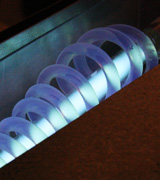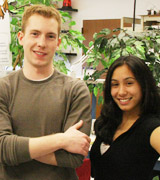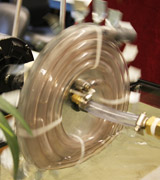Serving the World by Design
 In the 20 seconds it takes to grab a glass and fill it with water to quench your thirst, a child dies somewhere in the world due to a water-related disease.
In the 20 seconds it takes to grab a glass and fill it with water to quench your thirst, a child dies somewhere in the world due to a water-related disease.
To Devyn Byrnes, an electrical engineering major at Seattle Pacific, and his classmates this is unacceptable. Thanks to their SPU engineering education, they're prepared to do something about it.
Building on the Past for the Future
"Engineers don't necessarily create new knowledge," says Elaine Scott, professor of engineering and director of engineering programs at SPU. "They build on what people have learned and done before and use that knowledge to solve problems."
 To address the issue of unclean water, Byrnes and his classmates Bri Steigauf, Heather Garcia, Dan Troberg, and Muhammad Samhan knew they wanted to create an ultraviolet light purifier, since UV is capable of rendering inactive nearly all pathogens — including E. coli and salmonella — found in unclean water. But how would they power the purifier?
To address the issue of unclean water, Byrnes and his classmates Bri Steigauf, Heather Garcia, Dan Troberg, and Muhammad Samhan knew they wanted to create an ultraviolet light purifier, since UV is capable of rendering inactive nearly all pathogens — including E. coli and salmonella — found in unclean water. But how would they power the purifier?
An "a-ha moment" came when the group realized they could use the contaminated water to help clean itself. And they would do it by building on an idea from ancient times: the Archimedes screw, a spiral pump originally used to move water from low-lying bodies of water into irrigation ditches.
"We realized that we could put a spiral pump in a contaminated waterway," says Byrnes. "As long as the river flowed and the screw turned, it could pump water nearly 5 miles on flat terrain to a village, flow through a sand filter and then through an ultraviolet light chamber we set up."
Plus it would generate the electricity needed to charge the battery that powers the UV chamber, similar to how an alternator in a car charges the battery as the car runs.
As a result, with minimal maintenance, one hydroelectric water purification kit could be installed in a day, run day and night, last 10–15 years, generate an estimated 10 liters of safe water per day per person for a community of 300 people, and save 50–60 children from diarrheal-related deaths.
Real Experience and Real Jobs
This is just one of the many world-changing ideas students in SPU's engineering program are designing.
Another engineering team developed a smart power strip that disconnects and restores power to appliances based on both movement in a room and the power drain from individual appliances. This will help stave off lost energy and the billions of dollars associated with it, as well as reduce carbon emissions.
In both examples, it's the students' ability to identify problems in the world and then apply theory and practical experience for fresh solutions that stands out.
"We have a lot of applied projects," says Professor Scott. "That's a characteristic of SPU's engineering program. Starting with freshmen all the way through senior design projects, applied learning and open-ended projects are fully integrated into our academics."
Instead of just covering academic theory in classes, SPU's projects lead students to connect their learning and designs with real-world challenges. Mandatory internships for all engineering students also provide essential experience and, just as importantly, close connection with professionals in the engineering field.
"We have had tremendous success year over year hiring interns from SPU, as well as direct hires," says Dean Kato, director of sales at Esterline Control Systems. "The caliber of people and the skillsets that they come with are tremendous. The SPU program has more rigor and it shows in the students we hire."
Investing in Students and the World
 Of course, the caliber of students that SPU graduates depends on the caliber of students SPU attracts. Thanks to a $600,000 grant from the National Science Foundation, Scott and her colleagues have been able to attract academically gifted students.
Of course, the caliber of students that SPU graduates depends on the caliber of students SPU attracts. Thanks to a $600,000 grant from the National Science Foundation, Scott and her colleagues have been able to attract academically gifted students.
"The grant allows us to provide scholarships to transfer students, which brings in students committed to engineering," says Scott. The scholarship, which is for up to $10,000 a year for three years, was a definite factor in Byrnes decision to attend SPU.
"Along with lots of other financial aid SPU offered, the scholarship helped make SPU the least expensive of the schools I was looking at," adds Byrnes. "Plus I really liked the friendly campus and the small class sizes. It's easy to get to know your professors. They want to talk to you, and always want to meet for coffee."
The ability to build close, working relationships with their students also helps the engineering faculty invest in their students in another distinctive way: through an integration of faith with academics. Whether it's a professor pointing out how an experience in the lab is similar to an incident in the Bible, or a faculty member discussing how his work with circuits serves God, conversations around faith are common.
It's this dimension that perhaps challenged Devyn Byrnes the most.
"We've had lots of discussions about how to serve the world as engineers," he says. "I didn't see it at first, how what I was studying could serve the world. But now with our water purifying project I do. Engineers can change the world. They can do good and serve."
View Feature Story Archives


